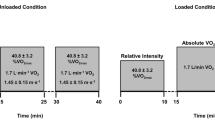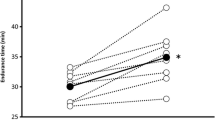Abstract
Purpose
The Elevation Training Mask (ETM) has been assessed for its impact on exercise performance using acute and training protocols. Although the ETM is widely available to consumers, little research exists for validation of the ETM mask settings. Therefore, the purpose of this study was to compare physiological responses during exercise for the ETM mask settings against moderate hypobaric hypoxia.
Methods
Nine participants living at moderate altitude (1600–1650 m) rested (10 min) and cycled in hypobaric hypoxia simulating 2743 m (ALT), in hypobaric hypoxia simulating 1829 m with the ETM set to 914 m (ALT + ETM), and with the ETM set to 2743 m (ETM) in a randomized order. Participants cycled for 20 min at 60% VO2max as determined by a maximal exertion test (VO2max) at baseline altitude. Oxygen consumption was measured throughout each test.
Results
There were no differences between conditions at rest. Repeated measures ANOVA showed the ALT condition elicited significantly greater VO2 compared to the ETM condition and 60% VO2max at baseline altitude (P < 0.05).
Conclusion
When cycling at a matched workload, the exercising VO2 was higher in the ALT condition than at the ETM mask setting of 2743 m and exercising VO2 during the ETM condition was similar to 60% VO2max at baseline altitude. The results of this study indicate that the ETM did not produce additional metabolic stress compared to hypobaric hypoxia during steady-state exercise in moderate-altitude living individuals.


Similar content being viewed by others
Availability of data and material
Available upon request.
References
Arlington, Va. Is #1 ‘Fittest City’—2019 American Fitness Index Ranks 100 Cities. (n.d.). 2019. https://www.acsm.org/read-research/newsroom/news-releases/news-detail/2019/05/14/arlington-va.-is-1-fittest-city---2019-american-fitness-index-ranks-100-cities. Accessed 24 Dec 2019
Balke B, Nagle FJ, Daniels J. Altitude and maximum performance in work and sports activity. JAMA. 1965;194(6):646–9. https://doi.org/10.1001/jama.1965.03090190068016.
Bellovary BN, King KE, Nuñez TP, McCormick JJ, Wells AD, Bourbeau KC, Fennel ZJ, Li Z, Johnson KE, Moriarty T, Mermier CM. Effects of high-intensity interval training while using a breathing-restrictive mask compared to intermittent hypobaric hypoxia. J Human Sport Exerc. 2019;14(4):821–33. https://doi.org/10.14198/jhse.2019.144.11.
Biggs N, England B, Turcotte N, Cook M, Williams A. Effects of simulated altitude on maximal oxygen uptake and inspiratory fitness. Int J Exerc Sci. 2017;10(1):128–36.
Borg GAV. Psychophysical bases of perceived exertion. Med Sci Sports Exerc. 1982;14(5):377–81. https://doi.org/10.1249/00005768-198205000-00012.
Coyle EF, González-Alonso J. Cardiovascular drift during prolonged exercise: new perspectives. Exerc Sport Sci Rev. 2001;29(2):88–92.
Davis JA, Frank MH, Whipp BJ, Wasserman K. Anaerobic threshold alterations caused by endurance training in middle-aged men. J Appl Physiol. 1979;46(6):1039–46. https://doi.org/10.1152/jappl.1979.46.6.1039.
Friedmann-Bette B. Classical altitude training: Classical altitude training. Scand J Med Sci Sports. 2008;18:11–20. https://doi.org/10.1111/j.1600-0838.2008.00828.x.
Geiser J, Vogt M, Billeter R, Zuleger C, Belforti F, Hoppeler H. Training High-living low: changes of aerobic performance and muscle structure with training at simulated altitude. Int J Sports Med. 2001;22(08):579–85. https://doi.org/10.1055/s-2001-18521.
Gore CJ, Hahn AG, Aughey RJ, Martin DT, Ashenden MJ, Clark SA, Garnham AP, Roberts AD, Slater GJ, McKenna MJ. Live high:train low increases muscle buffer capacity and submaximal cycling efficiency. Acta Physiol. 2001;173(3):275–86.
Gore CJ, Clark SA, Saunders PU. Nonhematological mechanisms of improved sea-level performance after hypoxic exposure. Med Sci Sports Exerc. 2007;39(9):1600–9. https://doi.org/10.1249/mss.0b013e3180de49d3.
Granados J, Gillum TL, Castillo W, Christmas KM, Kuennen MR. “Functional” respiratory muscle training during endurance exercise causes modest hypoxemia but overall is well tolerated. J Strength Cond Res. 2016;30(3):755–62. https://doi.org/10.1519/JSC.0000000000001151.
Guo G, Zhu G, Sun W, Yin C, Ren X, Wang T, Liu M. Association of arterial oxygen saturation and acute mountain sickness susceptibility: a meta-analysis. Cell Biochem Biophys. 2014;70(2):1427–32. https://doi.org/10.1007/s12013-014-0076-4.
Hamlin MJ, Marshall HC, Hellemans J, Ainslie PN, Anglem N. Effect of intermittent hypoxic training on 20 km time trial and 30 s anaerobic performance. Scand J Med Sci Sports. 2009;20(4):651–61.
Jung HC, Lee NH, John SD, Lee S. The elevation training mask induces modest hypoxaemia but does not affect heart rate variability during cycling in healthy adults. Biol Sport. 2018;36(2):105–12. https://doi.org/10.5114/biolsport.2019.79976.
Mazzeo RS, Bender PR, Brooks GA, Butterfield GE, Groves BM, Sutton JR, Wolfel EE, Reeves JT. Arterial catecholamine responses during exercise with acute and chronic high-altitude exposure. Am J Physiol-Endocrinol Metab. 1991;261(4):E419–24. https://doi.org/10.1152/ajpendo.1991.261.4.E419.
Mazzeo RS. physiological responses to exercise at altitude: an update. Sports Med. 2008;38(1):1–8. https://doi.org/10.2165/00007256-200838010-00001.
Porcari JP, Probst L, Forrester K, Doberstein S, Foster C, Cress ML, Schmidt K. Effect of wearing the elevation training mask on aerobic capacity, lung function, and hematological variables. J Sports SciMed. 2016;15(2):379–86.
Purkayastha SS, Ray US, Arora BS, Chhabra PC, Thakur L, Bandopadhyay P, Selvamurthy W. Acclimatization at high altitude in gradual and acute induction. J Appl Physiol. 1995;79(2):487–92. https://doi.org/10.1152/jappl.1995.79.2.487.
Robergs RA. An exercise physiologist’s “contemporary” interpretations of the “ugly and creaking edifices” of the VO2max concept. J Exerc Physiol Online. 2001;4(1):1–44.
Secher NH, Vaage O, Jensen K, Jackson RC. Maximal aerobic power in oarsmen. Eur J Appl Physiol. 1983;51(2):155–62. https://doi.org/10.1007/BF00455178.
Tanaka K, Matsuura Y, Kumagai S, Matsuzaka A, Hirakoba K, Asano K. Relationships of anaerobic threshold and onset of blood lactate accumulation with endurance performance. Eur J Appl Physiol. 1983;52(1):51–6. https://doi.org/10.1007/BF00429025.
Tanaka K, Takeshima N, Kato T, Niihata S, Ueda K. Critical determinants of endurance performance in middle-aged and elderly endurance runners with heterogeneous training habits. Eur J Appl Physiol. 1990;59(6):443–9. https://doi.org/10.1007/BF02388626.
Warren BG, Spaniol F, Bonnette R. The effects of an elevation training mask on VO2Max of male reserve officers training corps cadets. Int J Exerc Sci. 2017;10(1):37–43.
Yoshiga CC, Higuchi M. Oxygen uptake and ventilation during rowing and running in females and males. Scand J Med Sci Sports. 2003;13(6):359–63. https://doi.org/10.1046/j.1600-0838.2003.00324.x.
Acknowledgements
The authors would like to thank the University of New Mexico’s Graduate and Professional Student Association for funding this research project through the New Mexico Research Grant.
Funding
University of New Mexico’s Graduate and Professional Student Association’s New Mexico Research Grant.
Author information
Authors and Affiliations
Corresponding author
Ethics declarations
Conflict of interest/Competing interest
The authors state there are no conflicts of interest.
Ethics approval
This research study and its protocols were approved by the University of New Mexico’s Office of the Institutional Review Board for human subject research.
Consent to participate
All consent forms used during the study were approved by the University of New Mexico’s Office of the Institutional Review Board for human subject research. All participants gave written informed consent to participate.
Rights and permissions
About this article
Cite this article
Bellovary, B.N., Wells, A.D., Fennel, Z.J. et al. Differences in Metabolic Stress Using a Breathing Restrictive Mask Compared to Hypobaric Hypoxia During Cycling at a Matched Workload. J. of SCI. IN SPORT AND EXERCISE 4, 397–404 (2022). https://doi.org/10.1007/s42978-021-00116-2
Received:
Accepted:
Published:
Issue Date:
DOI: https://doi.org/10.1007/s42978-021-00116-2




